
Quick Facts

Biography
William-Adolphe Bouguereau (French: [buɡ(ə)ʁo]; November 30, 1825 – August 19, 1905) was a French academic painter and traditionalist. In his realistic genre paintings he used mythological themes, making modern interpretations of classical subjects, with an emphasis on the female human body. During his life he enjoyed significant popularity in France and the United States, was given numerous official honors, and received top prices for his work. As the quintessential salon painter of his generation, he was reviled by the Impressionist avant-garde. By the early twentieth century, Bouguereau and his art fell out of favor with the public, due in part to changing tastes. In the 1980s, a revival of interest in figure painting led to a rediscovery of Bouguereau and his work. Throughout the course of his life, Bouguereau executed 822 known finished paintings, although the whereabouts of many are still unknown.
Life and career
William-Adolphe Bouguereau was born in La Rochelle, France, on November 30, 1825, into a family of wine and olive oil merchants. He seemed destined to join the family business but for the intervention of his uncle Eugène, a Roman Catholic priest, who taught him classical and Biblical subjects, and arranged for Bouguereau to go to high school. He showed artistic talent early on. His father was convinced by a client to send him to the École des Beaux-Arts in Bordeaux, where he won first prize in figure painting for a depiction of Saint Roch. To earn extra money, he designed labels for jams and preserves.

Through his uncle, Bouguereau was given a commission to paint portraits of parishioners, and when his aunt matched the sum he earned, Bouguereau went to Paris and became a student at the École des Beaux-Arts. To supplement his formal training in drawing, he attended anatomical dissections and studied historical costumes and archeology. He was admitted to the studio of François-Édouard Picot, where he studied painting in the academic style. Academic painting placed the highest status on historical and mythological subjects and Bouguereau won the coveted Prix de Rome at age 26 in 1850, with his Zenobia Found by Shepherds on the Banks of the Araxes. His reward was a year at the Villa Medici in Rome, Italy, where in addition to formal lessons he was able to study first-hand the Renaissance artists and their masterpieces, as well as Greek, Etruscan, and Roman antiquities. He also studied classical literature, which influenced his subject choice for the rest of his career.

Bouguereau, painting within the traditional academic style, exhibited at the annual exhibitions of the Paris Salon for his entire working life. An early reviewer stated, "M. Bouguereau has a natural instinct and knowledge of contour. The eurythmie of the human body preoccupies him, and in recalling the happy results which, in this genre, the ancients and the artists of the sixteenth century arrived at, one can only congratulate M. Bouguereau in attempting to follow in their footsteps ... Raphael was inspired by the ancients ... and no one accused him of not being original."
Raphael was a favorite of Bouguereau and he took this review as a high compliment. He had fulfilled one of the requirements of the Prix de Rome by completing an old-master copy of Raphael’s The Triumph of Galatea. In many of his works, he followed the same classical approach to composition, form, and subject matter. Bouguereau's graceful portraits of women were considered very charming, partly because he could beautify a sitter while also retaining her likeness.
In 1856, he married Marie-Nelly Monchablon and subsequently had five children. By the late 1850s, he had made strong connections with art dealers, particularly Paul Durand-Ruel (later the champion of the Impressionists), who helped clients buy paintings from artists who exhibited at the Salons. Thanks to Paul Durand-Ruel, Bouguereau met Hugues Merle, who later often was compared to Bouguereau. The Salons annually drew over 300,000 people, providing valuable exposure to exhibited artists. Bouguereau’s fame extended to England by the 1860s, and he bought a large house and studio in Montparnasse with his growing income.
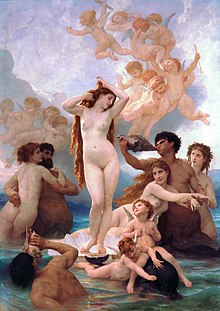
Bouguereau was a staunch traditionalist whose genre paintings and mythological themes were modern interpretations of Classical subjects, both pagan and Christian, with a concentration on the naked female human body. The idealized world of his paintings brought to life goddesses, nymphs, bathers, shepherdesses, and madonnas in a way that appealed to wealthy art patrons of the era.
Bouguereau employed traditional methods of working up a painting, including detailed pencil studies and oil sketches, and his careful method resulted in a pleasing and accurate rendering of the human form. His painting of skin, hands, and feet was particularly admired. He also used some of the religious and erotic symbolism of the Old Masters, such as the "broken pitcher" which connoted lost innocence.
Bouguereau received many commissions to decorate private houses, public buildings, and churches. As was typical of such commissions, Bouguereau would sometimes paint in his own style, and at other times conform to an existing group style. Early on, Bouguereau was commissioned in all three venues, which added enormously to his prestige and fame. He also made reductions of his public paintings for sale to patrons, of which The Annunciation (1888) is an example. He was also a successful portrait painter and many of his paintings of wealthy patrons remain in private hands.
Bouguereau steadily gained the honors of the Academy, reaching Life Member in 1876, Grand Medal of Honor in 1885., Commander of the Legion of Honor in 1885, Grand Officier of the Legion of Honor in 1905. He began to teach drawing at the Académie Julian in 1875, a co-ed art institution independent of the École des Beaux-Arts, with no entrance exams and with nominal fees.
In 1877, both his wife and infant son died. At a rather advanced age, Bouguereau was married for the second time in 1896, to fellow artist Elizabeth Jane Gardner Bouguereau, one of his pupils. He used his influence to open many French art institutions to women for the first time, including the Académie française.
Near the end of his life he described his love of his art: "Each day I go to my studio full of joy; in the evening when obliged to stop because of darkness I can scarcely wait for the next morning to come ... if I cannot give myself to my dear painting I am miserable." He painted 826 paintings.
In the spring of 1905, Bouguereau's house and studio in Paris were burgled. On August 19, 1905, Bouguereau died in La Rochelle at the age of 79 from heart disease.
- Depictions of nude women

The Bather - Baigneuse (1879)
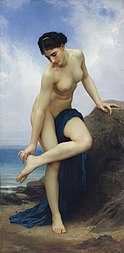
After the Bath (1875)

Baigneuse (1825-1905)

Baigneuse (1825-1905)
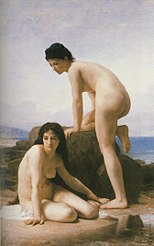
Les Deux Baigneuses (1884)
- Depictions of women in classical themes

Innocence
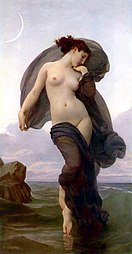
Soir, Evening or Evening Mood

L'Aurore or Dawn

Psyche
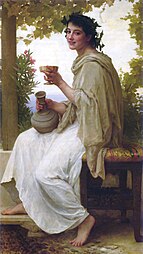
Bacchante (1894)
Fame, fall, and rise

In his own time, Bouguereau was considered to be one of the greatest painters in the world by the academic art community, and simultaneously he was reviled by the avant-garde. He also gained wide fame in Belgium, the Netherlands, Spain, and in the United States, and commanded high prices.
Bouguereau’s career was close to a direct ascent with hardly a setback. To many, he epitomized taste and refinement, and a respect for tradition. To others, he was a competent technician stuck in the past. Degas and his associates used the term "Bouguereauté" in a derogatory manner to describe any artistic style reliant on "slick and artificial surfaces", also known as a licked finish. In an 1872 letter, Degas wrote that he strove to emulate Bouguereau’s ordered and productive working style, although with Degas' famous trenchant wit, and the aesthetic tendencies of the Impressionists, it is possible the statement was meant to be ironic. Paul Gauguin loathed him, rating him a round zero in Racontars de Rapin and later describing in Avant et après (Intimate Journals) the single occasion when Bouguereau made him smile on coming across a couple of his paintings in an Arles' brothel, "where they belonged".
Bouguereau’s works were eagerly bought by American millionaires who considered him the most important French artist of that time. But even during his lifetime there was critical dissent in assessing his work; the art historian Richard Muther wrote in 1894 that Bouguereau was a man "destitute of artistic feeling but possessing a cultured taste [who] reveals... in his feeble mawkishness, the fatal decline of the old schools of convention." In 1926, American art historian Frank Jewett Mather criticized the commercial intent of Bouguereau’s work, writing that the artist "multiplied vague, pink effigies of nymphs, occasionally draped them, when they became saints and madonnas, painted on the great scale that dominates an exhibition, and has had his reward. I am convinced that the nude of Bouguereau was prearranged to meet the ideals of a New York stockbroker of the black walnut generation." Bouguereau confessed in 1891 that the direction of his mature work was largely a response to the marketplace: "What do you expect, you have to follow public taste, and the public only buys what it likes. That's why, with time, I changed my way of painting."
After 1920, Bouguereau fell into disrepute, due in part to changing tastes. Comparing his work to that of his Realist and Impressionist contemporaries, Kenneth Clark faulted Bouguereau’s painting for "lubricity", and characterized such Salon art as superficial, employing the "convention of smoothed-out form and waxen surface."
In 1974, the New York Cultural Center staged a show of Bouguereau's work partly as a curiosity, although curator Robert Isaacson had his eye on the long-term rehabilitation of Bouguereau's legacy and reputation. In 1984, the Borghi Gallery hosted a commercial show of 23 oil paintings and one drawing. In the same year a major exhibition was organized by the Montreal Museum of Fine Arts in Canada. The exhibition opened at the Musée du Petit-Palais, in Paris, traveled to The Wadsworth Atheneum in Hartford, and concluded in Montréal. More recently, resurgence in the artist's popularity has been promoted by American collector Fred Ross, who owns a number of paintings by Bouguereau and features him on his website at Art Renewal Center.
Since 1975 prices for Bouguereau's works have climbed steadily, with major paintings selling at high prices: $1,500,000 in 1998 for The Heart's Awakening, $2,600,000 in 1999 for Alma Parens and Charity at auction in May 2000 for $3,500,000. Bouguereau's works are in many public collections.
“Notre Dame des Anges” (“Our Lady of the Angels") was last shown publicly in the United States at the World’s Columbian Exhibition in Chicago in 1893. In 2002 it was donated to the Daughters of Mary Mother of Our Savior, an order of nuns is affiliated with Clarence Kelly's Traditionalist Catholic Society of St. Pius V. In 2009 the nuns sold it to an art dealer for $450,000, who was able to sell it for more than $2 million dollars. Kelly was subsequently found guilty by an Albany, New York jury of defaming the dealer in remarks made in a television interview.."
As a teacher
From the 1860s, Bouguereau was closely associated with the Académie Julian where he gave lessons and advice to art students, male and female, from around the world. During several decades he taught drawing and painting to hundreds, if not thousands, of students. Many of them managed to establish artistic careers in their own countries, sometimes following his academic style, and in other cases, rebelling against it, like Henri Matisse. He married his most famous pupil, Elizabeth Jane Gardner, after the death of his first wife.
Name

Sources on his full name are contradictory: it is sometimes given as William-Adolphe Bouguereau (composed name), William Adolphe Bouguereau (usual and civil-only names according to the French tradition), while in other occasions it appears as Adolphe William Bouguereau (with Adolphe as the usual name). However, the artist used to sign his works simply as William Bouguereau (hinting "William" was his given name, whatever the order), or more precisely as "W.Bouguereau.date" (French alphabet) and later as "W-BOVGVEREAV-date" (Latin alphabet).
Awards and honors
- 1848: Second Prix de Rome, for Saint Pierre après sa délivrance de prison, vient retrouver les fidèles chez Marie.
- 1850: Premier Prix de Rome, for Zenobie retrouvée par les bergers sur les bords de l'Araxe.
- 1859: Knight of the Legion of Honour
- 1876: Officer of the Legion of Honour
- 1881: Knight in the Order of Leopold
- 1885: Commander of the Legion of Honour
- 1885: Grand Medal of Honour
- 1905: Grand Officier of the Legion of Honour
- ^
- Handelsblad (Het) 15-05-1881
In literature
In Sir Arthur Conan Doyle's novel The Sign of the Four (1890), the character Mr Sholto remarks, "there cannot be the least question about the Bouguereau. I am partial to the modern French school."
Selected works

- La Danse (1856)
- Alone in the World (Latest 1867)
- The Knitting Girl (1869)
- The Elder Sister (1869)
- Nymphs and Satyr (1873)
- The Birth of Venus (1879)
- Evening Mood (1882)
- The Nut Gatherers (1882)
- The Return of Spring (1886)
- The First Mourning (1888)
- The Shepherdess (1889)
- Les murmures de l'Amour (1889)
- Gabrielle Cot, a portrait of Cot's daughter, 1890
- L'Amour et Psyché, enfants (1890)
- The Bohemian (1890)
- Le Travail interrompu (1891)
- The Goose Girl (1891)
- Innocence (1893)
- Rêve de printemps (1901)










